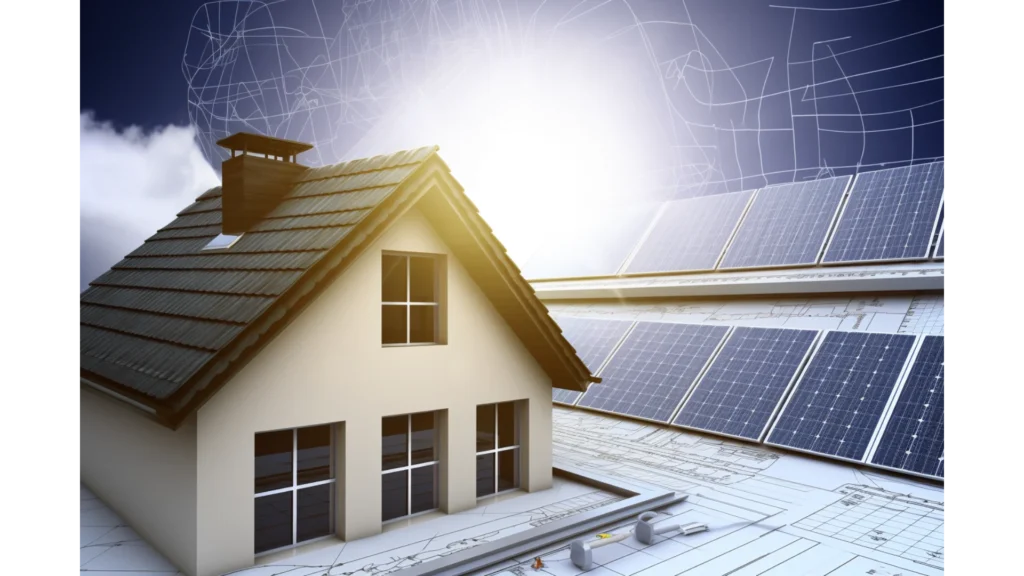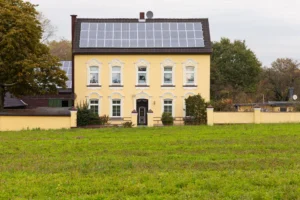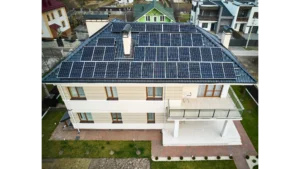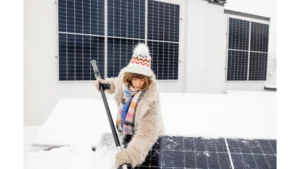
Residential solar systems have become increasingly popular as homeowners look for ways to generate their own electricity and reduce reliance on traditional energy sources. However, the efficiency of these systems can vary depending on various factors, including the type of panel used, installation location, and environmental conditions. In this article, we will explore the efficiency of residential solar systems in detail.
The use of renewable energy is a key factor in reducing carbon emissions and mitigating climate change. Residential solar systems are important to this shift towards sustainable energy sources. Understanding the factors that impact the efficiency of these systems is essential for homeowners looking to maximize their energy production and minimize their environmental impact. This article provides an overview of different types of solar panels, explores the factors that affect efficiency, such as installation location and environmental conditions, and offers tips for installing solar panels to achieve maximum efficiency in limited space.
The adoption of photovoltaic technology in the residential sector has seen significant advancements, prompting increased interest in the energy generation potential of households. Solar panels are popular for homeowners who want to generate electricity and reduce their carbon footprint. The efficiency of solar panels is crucial in determining how much energy they can produce and how much money homeowners can save on their utility bills.
There are several factors that determine the efficiency of residential solar systems, including the type of solar panel used, its orientation and tilt angle, location, weather conditions, shading from nearby buildings or trees, and system design. Monocrystalline solar panels are regarded as the most efficient due to their high silicon purity levels. However, polycrystalline and thin-film solar panels have also shown significant improvements in efficiency over time and may be more cost-effective for homeowners with limited space.
Achieving optimal efficiency from a residential solar system requires careful planning and installation by certified professionals. A qualified installer will assess factors such as roof size and pitch angle to determine your home’s most appropriate system design. They will also address any shading issues so that sunlight reaches all parts of the solar panel array throughout the day.
As more households adopt renewable energy sources like solar power to meet their electricity needs, it becomes increasingly important to understand what affects the performance of these systems. Investing in high-efficiency solar panels combined with proper installation processes can lead to long-term savings on utility bills while reducing greenhouse gas emissions. With advances in technology driving down costs over time, residential solar systems could become even more prevalent in homes worldwide.
Understanding the different types of solar panels available in the market is crucial for individuals looking to invest in renewable energy. The three main types are monocrystalline, polycrystalline, and thin-film solar panels. Monocrystalline solar panels are made from a single crystal structure, which makes them the most efficient type of panel, with an efficiency rate of 22-27%. These panels are ideal for smaller roofs since they can generate more power per square foot.
Polycrystalline solar panels are slightly less efficient than their monocrystalline counterparts but are also less expensive to produce and purchase. They have an efficiency rate ranging from 15-22% and can be used for larger installations where space is not a constraint. Thin-film solar panels have an efficiency rate similar to that of polycrystalline solar panels and offer flexibility in terms of installation since they can be mounted on curved surfaces or integrated into building materials. However, these panels require more space as compared to other types.
When choosing between the different types of solar panels, it is important to consider factors such as cost, efficiency, lifespan, aesthetics, and available roof space. Monocrystalline solar panels may provide better value for money over time due to their higher efficiency rates despite being more expensive initially. Polycrystalline solar panels may be a better option if budget constraints exist since they offer lower upfront costs while still providing adequate performance levels.
Understanding the differences between monocrystalline, polycrystalline, and thin-film solar panel options allows individuals to make informed decisions when investing in renewable energy solutions for their homes or businesses. By considering factors such as cost-effectiveness and available roof space during the selection processes, customers can select the best solution suited to their individual needs while minimizing the impact on both budgets and environmental resources.
Factors such as solar panel type, inverter efficiency, thermal cycling, orientation, and environmental conditions play a key role in determining the effectiveness of photovoltaic technology. The type of solar panel used is one of the most significant factors affecting its efficiency. Monocrystalline panels are the most efficient and have an efficiency rate ranging from 22-27%. Polycrystalline panels are less expensive but slightly less efficient than monocrystalline panels, with an efficiency rate ranging from 15-22%. Thin-film solar panels are lightweight and easy to move but are the least efficient type of solar panel, with an efficiency rate also ranging between 15-22%.
In addition to solar panel type, other factors that impact their effectiveness include inverter efficiency and thermal cycling. Inverters convert direct current (DC) electricity generated by solar panels into alternating current (AC) electricity that can be used at home. The higher the inverter’s efficiency level, the more energy it can convert for use in your home. Thermal cycling refers to changes in temperature that occur over time which can cause stress on a system’s materials leading to damage or decreased performance.
A crucial factor impacting the effectiveness of residential solar systems is orientation. South-facing roofs offer optimal sun exposure for maximum energy production, while west-facing roofs come next, followed by east-facing roofs. North-facing roofs do not receive sufficient sunlight for effective energy production, making them unsuitable for installation.
Finally, environmental conditions such as dust buildup on panels or snow accumulation affect their ability to generate power effectively. A table summarizing these factors is presented below:
Factors | Description |
|
|
Solar Panel Type | Monocrystalline > Polycrystalline > Thin-Film |
Inverter Efficiency | Higher Efficiency = More Energy Conversion |
Orientation | South-Facing Best > West-Facing |
Thermal Cycling | Changes in Temperature Impact Materials & Performance |
Environmental Conditions | Dust, Snow Accumulation Affect Efficiency |
In summary, several factors impact the efficiency of residential solar systems. While the type of solar panel used is one of the most significant factors affecting efficiency, other factors such as inverter efficiency, thermal cycling, orientation and environmental conditions also play a critical role. Considering these determinants can help homeowners maximize their energy production and cost savings while reducing their carbon footprint.
A comparison between monocrystalline and polycrystalline solar panels is a significant aspect of understanding the technical differences in photovoltaic technology. Monocrystalline solar panels are made from a single crystal of silicon and are considered the most efficient type of solar panel, with an efficiency rate that ranges from 22-27%. They are also considered more aesthetically pleasing due to their uniform black color.
On the other hand, polycrystalline solar panels are made by melting multiple fragments of silicon, resulting in lower efficiency rates than monocrystalline panels. However, they are also less expensive to produce and install than monocrystalline panels. Polycrystalline panels have an efficiency rate that ranges from 15-22% and has a blue-ish tint due to their manufacturing process.
While there is no clear winner between these two types of solar panels, choosing the best option depends on several factors such as budget, energy consumption needs, roof size, and orientation. Monocrystalline panels may be more expensive initially but ultimately pay off in terms of higher energy generation per square foot over time. Meanwhile, polycrystalline panels may be a better choice for homeowners with larger roofs or limited budgets.
When it comes to choosing between monocrystalline and polycrystalline solar panels for residential use, it is important to weigh the pros and cons based on individual circumstances like budgetary constraints or energy requirements. While both types offer benefits like renewable energy production and cost savings in the long run, homeowners should determine what factors matter most before deciding which type of panel will provide optimal performance for their home’s unique needs.
Thin-film solar panels offer a flexible and lightweight alternative to traditional crystalline silicon solar panels, making them an attractive option for certain applications. These types of solar panels are made by depositing thin layers of photovoltaic material onto a substrate, such as glass or plastic. Thin-film solar panels are typically less expensive to produce than crystalline silicon solar panels but have lower efficiency rates.
The efficiency rate for thin-film solar panels ranges from 7-13%, with some models reaching up to 22%. This is lower than the efficiency rate for monocrystalline and polycrystalline solar panels, which can reach up to 27% and 22%, respectively. However, the lower production cost and installation flexibility make thin-film solar panels an attractive option for certain projects.
One potential application for thin-film solar panels is in building-integrated photovoltaics (BIPV). BIPV involves integrating photovoltaic materials, such as walls or roofing materials, into the building envelope. Thin-film solar panels are well-suited for this application due to their flexibility and ability to conform to irregular surfaces. They can also be produced in a variety of colors, allowing them to blend seamlessly with the surrounding architecture.
While thin-film solar panels may not be as efficient as other types of photovoltaic materials, they offer unique advantages in terms of flexibility and cost-effectiveness. As technology continues to improve and advancements are made in production processes, it’s likely that we will see increased adoption of thin-film solar panel technology across various industries.
Thin-film solar panels are the least efficient type of solar panel, with an efficiency rate ranging from 15-22%. However, they are lightweight, flexible, and easy to move. In contrast, monocrystalline solar panels are the most efficient type of solar panel available on the market today. They are often installed in larger energy systems with an efficiency rate ranging from 22-27%. Polycrystalline solar panels, on the other hand, are less expensive but less efficient than monocrystalline panels.
Inverter efficiency is another factor affecting residential solar systems’ overall efficiency. The inverter plays a crucial role in converting direct current (DC) electricity generated by solar panels into alternating current (AC) electricity used in households. The higher the inverter’s efficiency rate, the more energy can be produced from a given amount of sunlight. Therefore, selecting an appropriate inverter is essential for optimizing energy production.
Factors that impact inverter efficiency include temperature fluctuations and shading caused by nearby trees or buildings. Additionally, different types of inverters have varying levels of efficiency and their own pros and cons depending on specific needs and use cases.
To maximize overall system performance and ensure optimal energy output for residential users, it is important to consider both panel and inverter efficiencies when choosing a solar power system for one’s home.
Bullet point list:
Environmental factors can significantly impact the performance and output of solar panels, highlighting the importance of considering local conditions when planning for renewable energy adoption. While solar panels are designed to withstand various weather conditions, extreme temperatures, and weather events can significantly impair their efficiency. For instance, the high surface temperature reduces solar panel efficiency by increasing resistance in the circuit, leading to voltage drops. Similarly, snow accumulation on panels decreases efficiency by blocking sunlight from reaching photovoltaic cells.
To further understand how environmental factors affect solar panel efficiency, consider a table showing the impact of common weather events on solar panel performance (see table below). The table compares different types of solar panels under varying conditions, such as hailstorms, dust buildup, and shading. It shows that thin-film solar panels tend to have a lower tolerance to such disruptions compared to monocrystalline or polycrystalline ones.
Aside from weather events impacting energy production, other environmental factors like air pollution also affect the longevity and function of a solar system. Chemical residues from industries or nearby highways can reduce efficiency over time due to soiling effects on reflectivity and transmittance of light through photovoltaic cells. Additionally, vegetation growth or surrounding buildings may cause shading issues that could decrease output.
Therefore, it is imperative to assess local environmental conditions before installing a residential solar system. A certified installer will be able to provide an accurate assessment taking into account shading analysis and site-specific information such as wind patterns and average sun hours per day. This information will help homeowners choose the most efficient type of panel for their specific location, with consideration given to any potential long-term environmental impacts.
While installation costs are certainly important when evaluating home-based renewable energy options like residential rooftop systems, it is essential not to overlook local environment-related concerns as these play an equally significant role in determining both the short- and long-term economic viability of such installations.
Weather Event | Impact on Solar Panel Efficiency |
|
|
Hailstorm | Can cause irreversible damage |
High Temperatures | Lowers solar panel efficiency |
Snow Accumulation | Blocks sunlight from reaching panels |
Bird Droppings | Can also block sunlight and cause potential damage to the panels |
Dust Buildup | Decreases efficiency |
Shading | Reduces energy output |
The color of the back sheets protecting solar panels can significantly impact their performance, highlighting the importance of considering this factor when choosing a suitable product for one’s home. The back sheets, typically made of polymer materials, act as a protective layer for solar cells against environmental factors such as moisture and UV radiation. The color of the back sheets plays a crucial role in determining how much light is reflected or absorbed by the panel. Darker colors tend to absorb more light, while lighter colors reflect more light.
Studies have shown that white or light-colored back sheets increase the efficiency of solar panels by reflecting more sunlight onto them, resulting in higher energy output. On average, white back sheets have been found to increase panel efficiency by around 2% compared to black ones. This may seem like a small difference, but it can add up over time and lead to significant savings on electricity bills. Furthermore, using lighter-colored back sheets can also help reduce heat buildup within the panel and extend its lifespan.
Despite these advantages, not all manufacturers offer white or light-colored back sheets due to their higher cost compared to conventional black ones. However, it is worth noting that some manufacturers are now offering custom colors at no additional cost as demand for high-efficiency products increases. It is, therefore, crucial for consumers to consider both the efficiency and aesthetic aspects when choosing solar panels with regard to back sheet color.
Selecting an appropriate back sheet color can play a vital role in maximizing residential solar system efficiency and saving money on energy bills in the long run. While dark-colored back sheets may be more common due to their lower production costs, research has shown that using lighter shades can improve energy conversion rates and reduce heat buildup within panels. As renewable energy usage continues to grow worldwide, it is likely that we will see increased innovation and competition among manufacturers leading towards even greater advancements in photovoltaic technology, including new approaches towards improving back sheet design and creating better-performing products.
Snow and dust buildup on the surface of solar panels can significantly impact their ability to generate electricity, making it crucial for homeowners to take measures to prevent or remove these obstructions. Snow accumulation on solar panels can decrease efficiency by 100%, rendering them ineffective until snow removal. To prevent this from happening, homeowners should consider installing solar panel systems at an angle that allows snow to slide off easily. Some solar panel manufacturers also offer anti-snow coatings enabling the snow to melt quickly.
Dust and grime buildup on solar panels can also decrease their efficiency until they are cleaned. This is especially true in areas with high levels of pollution or construction debris. To maximize energy production, homeowners should clean their solar panels regularly using a soft brush and water. It is important not to use harsh chemicals or abrasive materials that could damage the protective layer on the panel’s surface.
While it may seem tedious, keeping solar panels free from snow and dust buildup can significantly impact overall energy production and cost savings. Regular maintenance ensures that each panel operates at its highest level of efficiency throughout the year. Homeowners who are unable or unwilling to perform regular maintenance themselves may want to consider hiring professional cleaning services.
In conclusion, maintaining clean and clear surfaces on residential solar systems is critical for optimal performance and maximum energy generation. Implementing measures such as installing anti-snow coatings or cleaning panels regularly will help ensure that the system produces electricity efficiently throughout its lifespan, leading to long-term cost savings for homeowners while reducing environmental impact through sustainable practices.
Maximizing energy production in limited space is crucial for homeowners looking to maximize cost savings and reduce environmental impact through sustainable practices. When it comes to residential solar systems, efficiency is especially important in situations where roof space is limited. Higher-efficiency panels can generate more electricity per square foot, making them better for smaller roofs. When the homeowner wants to maximize the number of panels, they can install them.
To achieve maximum efficiency in limited space, homeowners should consider several factors before installing solar panels on their property. These include selecting the most efficient panel type, ensuring proper installation and placement of panels, using an appropriate inverter system, and monitoring performance regularly. By focusing on these key areas, homeowners can ensure that their solar systems generate as much electricity as possible and reduce their reliance on traditional energy sources.
In addition to increasing energy production and cost savings, maximizing efficiency in limited space also has broader environmental benefits. Solar power is a clean and renewable source of energy that reduces greenhouse gas emissions by reducing reliance on fossil fuels. Homeowners can reduce their carbon footprint by choosing high-efficiency solar panels while enjoying all the benefits of renewable energy.
Overall, maximizing efficiency in residential solar systems is essential for homeowners who want to make the most out of their investment while contributing towards a more sustainable future. With careful planning and attention to detail during the installation and maintenance stages, it’s possible to get the maximum amount of electricity from even small rooftop spaces.
In conclusion, residential solar systems offer a promising alternative to traditional energy sources. However, the efficiency of solar panels can vary depending on multiple factors, such as panel type, installation location, and environmental conditions. Homeowners should consider the various types of solar panels available in the market and assess their individual needs before investing in them. Furthermore, installing the panels in an optimal location that receives direct sunlight for maximum efficiency is important.
Monocrystalline and polycrystalline are two different types of panels with varying efficiencies and price tags. Thin-film solar panels are another option that offers flexibility but lower efficiency compared to crystalline ones. Environmental factors such as snow buildup or back sheet color can also significantly impact overall performance. Therefore, homeowners must ensure regular maintenance to keep their systems running at maximum efficiency.
Ultimately, while it may be tempting to opt for cheaper options initially, investing in high-quality equipment and installation will pay off in the long run through higher yields and cost savings. Increased awareness about renewable energy systems combined with efficient technology has made residential solar systems an attractive investment opportunity for homeowners seeking a sustainable future with reduced carbon footprints.
Regular maintenance is required to keep residential solar systems functioning efficiently. Dirt and debris can accumulate on the panels, reducing their ability to absorb sunlight and generate electricity. It is recommended that homeowners clean their solar panels at least twice a year to prevent this buildup. In addition, it is important to regularly inspect the system for any damage or malfunctions, such as loose wiring or faulty inverters. While most solar panels are designed to withstand harsh weather conditions, extreme events such as hailstorms or hurricanes can cause damage that requires repair or replacement of the affected panels. Overall, proper maintenance can ensure that residential solar systems continue to provide reliable and cost-effective energy for years to come.
Residential solar systems can indeed be installed on flat roofs, but there are certain considerations that need to be taken into account. One of the main challenges with flat roofs is ensuring that the panels are angled correctly to receive maximum sunlight exposure. This can be achieved by using mounting structures specifically designed for flat roofs or installing ballast-mounted systems. Another consideration is the weight of the solar panels, which may require strengthening the roof structure. Additionally, regular maintenance and cleaning of the panels may be more challenging on a flat roof compared to an angled roof. However, with proper installation and maintenance procedures in place, residential solar systems can effectively generate electricity even on flat roofs.
The installation of a residential solar system requires obtaining the necessary permits from local authorities. The specific permits needed may vary depending on the location and regulations in place. In general, homeowners may need to obtain building permits for structural modifications required for solar panel installation, electrical permits for connecting the system to the grid, and zoning permits to ensure compliance with local land use laws. Some jurisdictions may also require environmental or historic preservation clearances before granting approval for solar panel installation. Working with a reputable installer who can help navigate the permit process and ensure that all necessary requirements are met before beginning installation is important.
Determining whether a residential solar system is producing enough energy for a home requires monitoring the system's output and comparing it to the home's energy usage. This can be done through a monitoring device that tracks the amount of electricity generated by the solar panels and consumed by the home. It is important to note that factors such as weather conditions, shading, and orientation can impact a solar system's efficiency and output. Regular maintenance and cleaning of the panels can also help ensure optimal performance. Overall, careful monitoring and attention to detail can help homeowners determine if their residential solar system is meeting their energy needs.
The lifespan of a residential solar system depends on various factors, including the quality of components used and the level of maintenance performed. On average, solar panels have a lifespan of 25-30 years, while inverters may need to be replaced after 10-15 years. However , some systems can last up to 40 years or more with proper care and maintenance. Regular cleaning and inspection can help ensure that the system is operating at peak efficiency and can identify any potential issues early on. It is also important to choose high-quality components from reputable manufacturers and have the installation done by certified professionals to ensure the longevity of the system.

Can I Install Solar Panels On A Historic Or Protected Home? Share: Facebook Twitter LinkedIn Pinterest As the world becomes increasingly aware of the need

The Sun’s Bounty: How Solar Energy Is Vital To Sustainability Share: Facebook Twitter LinkedIn Pinterest Are you tired of depending on fossil fuels for your

How Long Do Solar Panels Typically Last? Share: Facebook Twitter LinkedIn Pinterest Customers rightly ask , How Long Do Solar Panels Typically Last? Solar panels

How Does The Climate Effect The Efficiency Of Solar Panels? Share: Facebook Twitter LinkedIn Pinterest How Climate Effect The Efficiency Of My Solar Panels? Solar